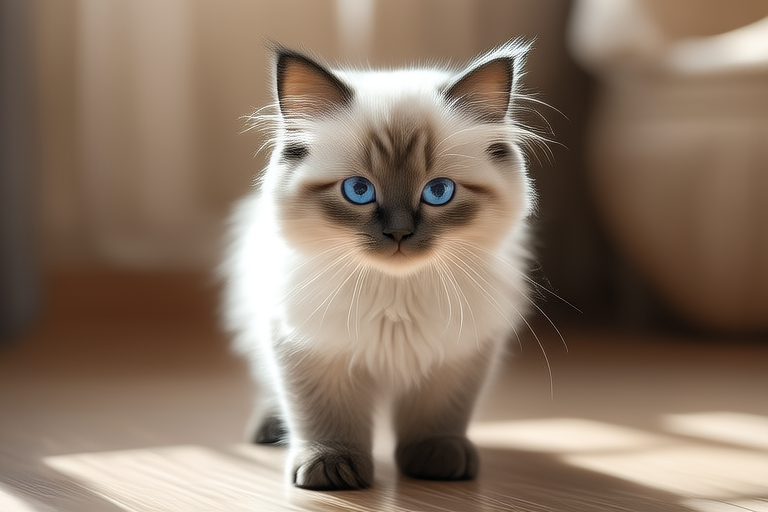The Coolest Traits You Didn’t Know About Ragdoll Cats
Ragdoll cats are renowned for their unique docility and affectionate nature, often described as “puppy-like” due to their tendency to follow their owners around and even allow themselves to be carried like a baby. These medium to large-sized felines are not only beautiful with their striking blue eyes and luxurious semi-longhair coats but also incredibly gentle and calm. However, beyond their well-known attributes, Ragdolls possess several lesser-known traits that make them truly fascinating companions.
Intelligence and Adaptability
One of the most underappreciated traits of Ragdoll cats is their intelligence. Despite their relaxed demeanor, Ragdolls are quick learners, often responding well to training and interactive play. They can learn tricks such as fetching toys or even walking on a leash. This intelligence paired with their adaptable nature makes them excellent companions for families with children or other pets. They adjust easily to new environments and routines, making them ideal for households that may experience frequent changes.
Ragdolls have a remarkable ability to acclimate to different living spaces. Whether it’s a bustling city apartment or a quiet countryside home, they can thrive in a variety of settings. Their adaptability is partly due to their history; originally bred in California, Ragdolls have been exposed to diverse environments, which has helped shape their versatile personalities.
Surprising Agility
Given their large size and laid-back nature, it might come as a surprise to many that Ragdolls are quite agile. Despite their weight, they can leap onto high surfaces with ease and navigate narrow spaces with grace. This agility is supported by their muscular bodies and strong hind legs, which enable them to perform impressive feats of athleticism. Their playful side often shines through during interactive games, where they can display their nimbleness.
Grooming Habits
Ragdolls have a semi-longhair coat that requires regular grooming to keep it in top condition. While they don’t shed excessively, their fur does need brushing at least twice a week to prevent matting and ensure it remains silky and smooth. Their grooming habits are relatively low-maintenance compared to some other long-haired breeds, thanks to their natural oil production, which helps keep their coat healthy. Regular brushing also helps distribute this natural oil, promoting a shiny coat.
Health Considerations
Like all purebred cats, Ragdolls have certain health conditions to be aware of. Hypertrophic cardiomyopathy (HCM), a heart disease, is more common in Ragdolls than in mixed-breed cats. Responsible breeding practices, including regular veterinary check-ups and genetic testing, can help mitigate the risk of HCM. Additionally, obesity is a concern for this breed due to their tendency to overeat if given the opportunity. Maintaining a healthy diet and ensuring adequate exercise are crucial for their well-being.
Historical and Genetic Factors
The history of Ragdolls is closely tied to their development and the traits they exhibit today. Ann Baker, a breeder from Riverside, California, is credited with creating the Ragdoll breed in the early 1960s. The original foundation cat, Josephine, was a white domestic longhair who had been injured in a car accident. After her recovery, she produced kittens that displayed the unique traits now associated with Ragdolls.
The genetic makeup of Ragdolls contributes significantly to their distinctive characteristics. Their docility and affection are thought to be linked to a recessive gene, which explains why not all offspring from Ragdoll parents exhibit these traits. The breed’s adaptability and intelligence can be attributed to selective breeding practices aimed at enhancing these desirable qualities.
Caring for Your Ragdoll Cat
Owning a Ragdoll cat can be a rewarding experience, but it does require commitment to their care. Providing a stimulating environment with plenty of toys and scratching posts will help keep your cat mentally and physically engaged. Regular veterinary visits, vaccinations, and parasite control are essential for maintaining their health.
Feeding your Ragdoll a balanced diet appropriate for their age, weight, and activity level is crucial. High-quality commercial cat foods are generally sufficient, but you may need to consult with a veterinarian about specific dietary needs based on your cat’s health status. Obesity prevention is particularly important for this breed, so monitoring portion sizes and encouraging regular playtime are vital.
Ragdolls love human interaction and companionship, so spending quality time with your cat is essential. Engaging in activities like playing fetch or teaching them simple tricks can strengthen the bond between you and your pet. Their affectionate nature means they will appreciate any attention you give them.
In conclusion, Ragdoll cats are more than just beautiful and affectionate companions; they are intelligent, adaptable, and surprisingly agile creatures. Understanding their unique traits and providing proper care will ensure that you and your Ragdoll cat enjoy a happy and healthy life together. The rewards of owning a Ragdoll cat extend far beyond their physical appearance; their loving and loyal nature makes them cherished members of many households.
